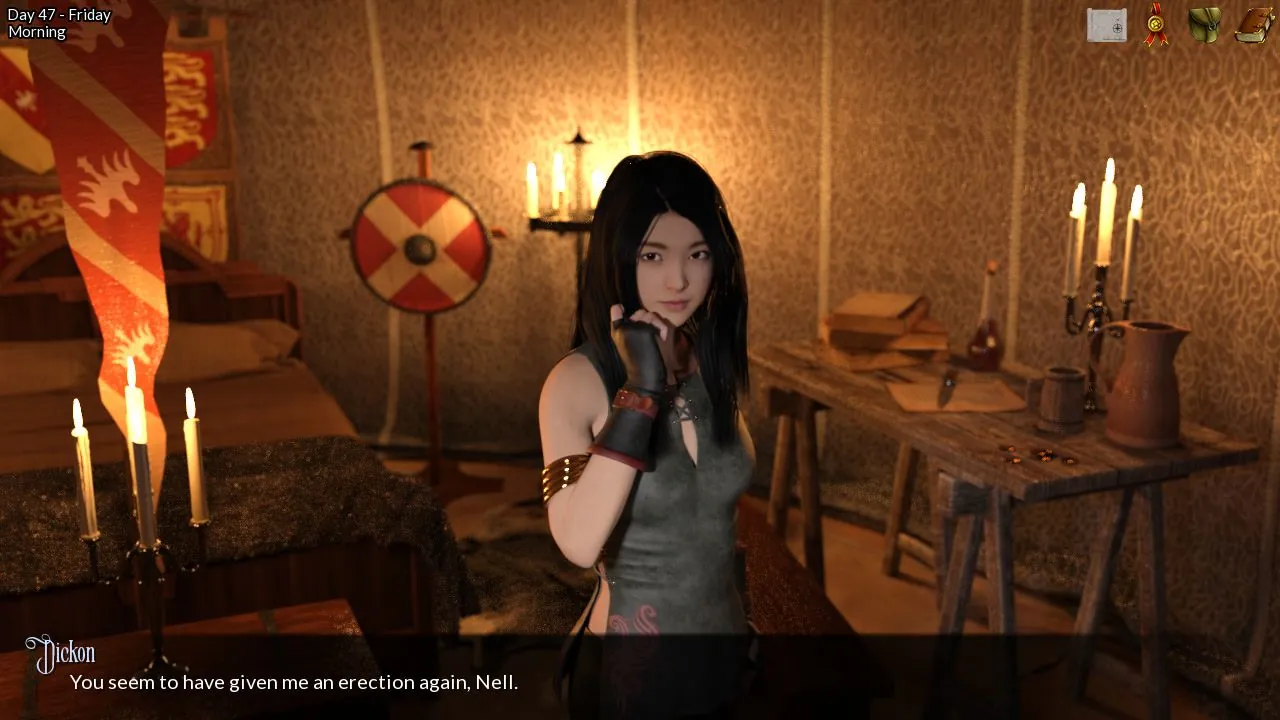
Play Deliverance
Deliverance review
Explore storylines, gameplay mechanics, and character relationships in this narrative-driven experience
Deliverance stands out as a narrative-focused adult game that combines engaging storytelling with meaningful player choices. This comprehensive guide explores what makes Deliverance unique in the adult gaming landscape, from its branching storylines to its relationship mechanics. Whether you’re new to the game or looking to deepen your understanding of its systems, this article covers everything you need to know about gameplay, character interactions, and the various paths available throughout your experience.
Understanding Deliverance: Core Gameplay and Story Structure
Let me tell you about the first time I truly understood what makes the Deliverance adult game special. I was several hours into a playthrough, deeply invested in the story, when I made what seemed like an innocent comment to a key character at a party. 🤔 I didn’t think much of it—just a bit of playful teasing. Two in-game weeks later, that single offhand remark came back to haunt me, completely altering the trajectory of my relationship and locking me out of a story path I’d been carefully cultivating for hours. I was stunned. This wasn’t just a game; it was a lesson in consequence. 🙌
That moment of genuine surprise is the heart of Deliverance. It’s not just about watching a story unfold; it’s about actively shaping it with every decision you make. If you’re tired of visual novels where your choices feel meaningless, you’re in for a treat. 🎁
### What Makes Deliverance Different From Other Adult Games
So, what sets this experience apart? It’s simple: meaningful consequence. Many story-driven games pay lip service to the idea of choice, but Deliverance builds its entire world around it. The game remembers everything. 🧠
I’ve played my fair share of titles where dialogue options are just flavor text, leading to the same predetermined conclusion. It’s frustrating! You feel like you’re on rails, merely a passenger. Deliverance throws you into the driver’s seat and hands you the keys to a complex, living world. The player choice system here isn’t a gimmick; it’s the core engine of the entire narrative.
Here’s what truly defines the Deliverance experience:
- A Living, Breathing World: Characters have their own schedules, memories, and motivations. If you promise to meet someone and then blow them off, they will remember. Their future interactions with you will be colored by that neglect. 😥
- No “Right” Answers: Unlike games with obvious “good” or “bad” dialogue picks, Deliverance presents you with genuinely tough calls. Do you tell a difficult truth to maintain honesty, or a comforting lie to preserve a fragile peace? There’s no guidebook for morality here.
- Emotional Weight: The game isn’t afraid to let you fail. You can irreparably damage relationships, close off entire story arcs, and experience endings that are bittersweet or downright tragic. This emotional stakes are what make the successes so incredibly rewarding. 🏆
Pro Tip: Don’t save-scum! Resist the urge to reload after every minor mistake. Some of the most memorable and authentic moments in my playthroughs came from dealing with the unintended consequences of my actions.
The magic of Deliverance is that it trusts you, the player, to navigate its complexity. It doesn’t hold your hand; it presents you with a world and says, “Make it yours.” This philosophy is most evident in the incredible web of its narrative branches.
### Story Branches and Player Choice Systems
At its core, the narrative of the Deliverance adult game is a sprawling tree, not a straight line. The branching storyline choices you make act as the pruning shears, constantly shaping which branches grow and which wither away. 🌳
The system is deceptively simple on the surface. You click through dialogue and select your responses. But underneath, a sophisticated player choice system is constantly at work, tracking a myriad of variables that influence your journey. We’re not just talking about a simple “Karma” meter. The game tracks:
- Your reputation with each major character
- Hidden flags for key decisions (e.g., “Helped Alex in Chapter 2”)
- Timed choices that expire if you don’t act
- A comprehensive record of your past conversations and promises
Let me give you a case study from my own experience. Early on, you encounter a character, let’s call him “Leo,” who is being harassed by a creditor. You have a few branching storyline choices:
1. Pay off Leo’s debt immediately (costing you a significant amount of in-game currency).
2. Intimidate the creditor (requires having built up a “tough” reputation).
3. Negotiate a deal for more time (requires high persuasion skills).
4. Walk away and do nothing.
I chose option 4, thinking it was the most pragmatic choice for my cash-strapped character. Big mistake. 😬 This single decision had a butterfly effect. Leo was forced to leave town to escape his debts, completely removing his entire character routes from my game. Later, I discovered that Leo was a key link to unlocking a major political subplot. By neglecting him, I had unknowingly closed the door on a whole faction of the story and several unique story paths and endings.
This is the power of Deliverance’s design. The story paths and endings aren’t just a final switch at the game’s conclusion; they are being built, dismantled, and rebuilt with every interaction from the very first scene.
Key features of the branching narrative:
- Chapter Divergence: Major decisions can split the main plot into significantly different directions for entire chapters.
- Point of No Return: Certain narrative branches lock in your path, making it impossible to backtrack. This makes your choices feel permanent and weighty.
- Ending Variants: The final epilogue isn’t just a single scene. It’s a detailed summary of how your choices affected every major character and the world itself, leading to dozens of possible conclusions.
Navigating this can be daunting, which is why the community has developed excellent fan-made guides. These walkthroughs are essential tools for mapping the game’s complex decision trees and understanding how to achieve specific outcomes. 📚
### Character Development and Relationship Mechanics
If the branching story is the skeleton of Deliverance, then the relationship mechanics are its beating heart. ❤️ This is where your connection to the world becomes personal, and it’s all governed by the brilliant, and sometimes cruel, affection points system.
Don’t let the term “affection points” fool you into thinking it’s a simple numbers game. It’s far more nuanced. Your relationship with each character is a multi-faceted profile. The game doesn’t just track if they “like” you; it tracks why they like you, what they respect about you, and what your history together entails.
The affection points system is often hidden from the player. You won’t see a numerical value floating above a character’s head. Instead, you have to read the subtle cues: their body language, the tone of their voice, the content of their dialogue. A character might have high affection for you but still be deeply disappointed in a specific choice you made, creating a wonderfully complex dynamic.
Here’s a practical breakdown of how to navigate these relationship mechanics:
- Consistency is Key: Characters respond to patterns. If you are consistently supportive and kind, they will learn to trust you. If you are hot and cold, they will become distant and wary.
- Remember the Details: Pay attention to what characters tell you. If someone mentions their love for classical music, later gifting them a vintage record will have a much greater impact than a generic, expensive present. 🎵
- Timing Matters: Supporting a character during a moment of crisis is infinitely more valuable than a dozen friendly chats during peaceful times. Be there for them when it counts.
- Manage Your Time: You cannot pursue every character routes simultaneously in a single playthrough. Relationships require time and attention. Neglecting one to pursue another will have consequences, and characters will notice if you’re spreading yourself too thin.
To help you visualize the different paths available, here is a comparison of some major character routes, their core story themes, and the pivotal choices that define them.
| Character Route | Core Storyline Theme | Key Decision Points |
|---|---|---|
| Elena – The Idealist Artist | Freedom vs. Responsibility; Challenging the Status Quo | Choosing to support her public protest, deciding whether to sell her art for commercial success or preserve its original message, handling her conflict with her traditional family. |
| Marcus – The Guard with a Past | Loyalty vs. Justice; Redemption | Trusting his intuition on a security breach versus following official orders, uncovering the truth about his former partner’s dishonor, helping him confront or hide from his past. |
| Kai – The Cunning Informant | Trust vs. Deception; Power and Information | Sharing critical intelligence with him or withholding it for leverage, aligning with his ruthless methods or appealing to his hidden morals, deciding whether your partnership is transactional or genuine. |
| Seraphina – The Reluctant Leader | Duty vs. Desire; The Burden of Command | Advising her to make a pragmatic but cruel decision for the community’s good or a kind but risky one, supporting her personal ambitions versus the established traditions she is bound to. |
The beauty of these character routes is that they are not isolated. Your relationship with Elena might directly impact your standing with Seraphina, as their goals and ideologies often clash. The affection points system is constantly interacting with the wider world state, creating a dynamic social ecosystem. 🌍
My most rewarding playthrough was one where I focused entirely on Marcus’s route. By dedicating my time to earning his trust and helping him seek redemption, I unlocked a deeply personal storyline about sacrifice and second chances that I had completely missed in previous attempts. It felt less like I was “completing a route” and more like I was helping a friend find peace. That emotional payoff is what you play for.
Ultimately, the Deliverance adult game is a masterpiece of interactive storytelling because it respects your intelligence and your agency. Your choices, both big and small, weave together to create a narrative that is uniquely yours. It’s a game that demands to be played more than once, not out of completionist obsession, but because you’ll be genuinely curious to see how a different set of branching storyline choices can create a completely different, yet equally compelling, world. ✨
Deliverance offers a rich narrative experience built on player choice and meaningful relationships. From understanding the core mechanics of the relationship system to mastering strategic decision-making, this guide provides the foundation for enjoying everything the game has to offer. Whether you’re pursuing a single romantic path or exploring multiple storylines, the key to maximizing your experience lies in understanding how your choices ripple through the narrative. Take your time with the game, experiment with different approaches, and don’t hesitate to consult walkthroughs when you want to explore specific content. Each playthrough reveals new layers of the story, making Deliverance a game that rewards both careful planning and spontaneous exploration.



























